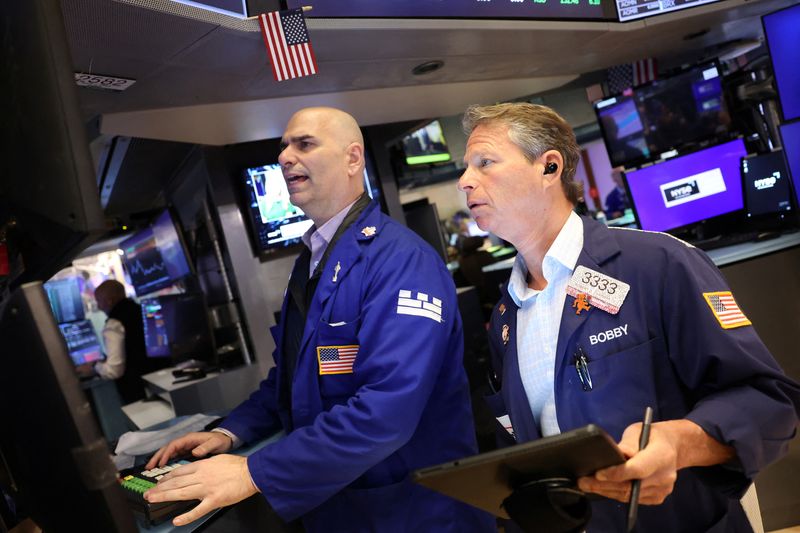Select Language

1. Futures muted
U.S. stock futures were subdued on Friday, after Wall Street’s main averages logged steep gains in the prior session on economic data which cemented expectations for a Federal Reserve interest rate cut next week.
By 03:34 ET (07:34 GMT), the S&P 500 had slipped by 3 points, or 0.1%, Nasdaq 100 futures were mostly unchanged and Dow futures had dipped by 32 points, or 0.1%.
On Thursday, the blue-chip Dow Jones Industrial Average notched a record-high close. The benchmark S&P 500 and tech-heavy Nasdaq Composite also rose by 0.85% and 0.72%, respectively, touching all-time peaks as well.
Underpinning sentiment were figures showing that U.S. consumer price growth accelerated in August, albeit roughly in line with expectations, while weekly initial jobless claims ticked up to nearly a four-year high. The numbers reinforced bets that the Fed would slash rates at its September 16-17, with officials seen prioritizing an easing labor market over sticky inflation.
Markets are now all but certain the Fed will reduce borrowing costs from their current range of 4.25% to 4.5% by at least 25 basis points, according to CME’s FedWatch Tool. There is around a 7% chance the central bank will opt for a deeper, half-point drawdown.
Along with the data, the indices were buoyed by a surge in shares in electric carmaking giant Tesla. Micron Technology also advanced by 7.5% following a move by Citigroup to lift its price target of the memory chip manufacturer.
2. Adobe raises outlook
Adobe raised its annual financial forecasts, citing solid demand for its artificial intelligence-enhanced design software tools.
Shares in the maker of popular editing platforms like Photoshop and Premiere Pro increased by a little over 3% in extended hours trading.
Still, the stock has slipped by more than 20% so far this year, as investors fret over Adobe’s ability to show returns from its heavy investments in AI. Grappling with intensifying competition from smaller peers like Figma, Adobe has rolled out Firefly, which harnesses AI to help users craft videos and images from text prompts.
Analysts remain worried that Firefly may not spur widespread adoption of Adobe’s offerings, although CFO Dan Durn told Reuters that new users and subscribers have been the predominant drivers of growth.
Adobe said it now expects fiscal 2025 revenue to between $23.65 billion and $23.70 billion, compared to $23.50 billion to $23.60 billion previously. Full-year adjusted per-share profit is tipped to come in at $20.80 to $20.85, versus a prior outlook of $20.50 to $20.70.
3. Michigan consumer sentiment survey ahead
Investors will have the chance to pour through more economic indicators on Friday, with the headliner set to be a gauge of consumer sentiment from the University of Michigan.
Economists anticipate that the survey for September will match the prior month. In August, the measure slipped to 58.2, as households remained concerned by the potential impact of sweeping U.S. tariffs on prices.
Consumers’ 12-month inflation expectations ticked up to 4.8%, which would be well above the 2% target level pursued by the Fed. Long-run expectations came in at 3.5%. Analysts at ING said they would be "keeping a close eye" on these numbers.
On Thursday, figures from the Bureau of Labor Statistics showed that the consumer price index was 2.9% in the 12 months to August, compared to 2.7% in July and matching economists’ expectations. Month-on-month, the inflation gauge stood at 0.4%, faster than 0.2% in the prior month and slightly above forecasts of 0.3%.
4. Microsoft, OpenAI reach non-binding deal over OpenAI restructuring
Microsoft (NASDAQ:MSFT) and OpenAI said on Thursday evening that they had reached a non-binding agreement over the AI start-up’s plans to transition to a for-profit organization.
Shares of Microsoft were higher in after-market trade following the announcement.
No specific terms of the arrangement were released by the firms, who in a joint statement said the agreement was for the “next phase” of their partnership. The two said they are “actively working to finalize contractual terms in a definitive agreement.”
OpenAI said the company’s non-profit entity will receive over $100 billion -- or around a fifth of the $500 billion valuation it is seeking in public markets -- "making it one of the most well-resourced philanthropic organizations in the world."
Faced with burgeoning revenue and a need to secure greater computing capacity to meet soaring demand, OpenAI has been looking to adopt a more conventional corporate structure and lock in partnerships with a wider variety of cloud providers. Microsoft, which previously had exclusive rights to sell OpenAI’s tools, has softened its hold in recent months, allowing OpenAI to go after a massive data center project.
5. Oil falls
Oil prices dipped, adding to the previous session’s sharp losses on fears around oversupply as well as a possible weakening in U.S. demand.
At 03:34 ET, Brent futures dropped 0.7% to $65.91 a barrel, and U.S. West Texas Intermediate crude futures fell 0.7% to $61.92 a barrel.
Oil fell nearly 2% on Thursday, but the crude benchmarks are still on course for weekly gains after strength at the start of the week on the potential for disruptions to output or trade flows from conflict and war.
An Energy Information Administration report on Wednesday said U.S. crude stocks rose last week by 3.9 million barrels to 424.6 million barrels, suggesting demand in the largest energy consumer in the world is set to slow as the year progresses.
Additionally, the International Energy Agency said in its monthly report world oil supply would rise more rapidly than expected this year due to planned output increases by the Organization of the Petroleum Exporting Countries and allies like Russia, a group known as OPEC+.

